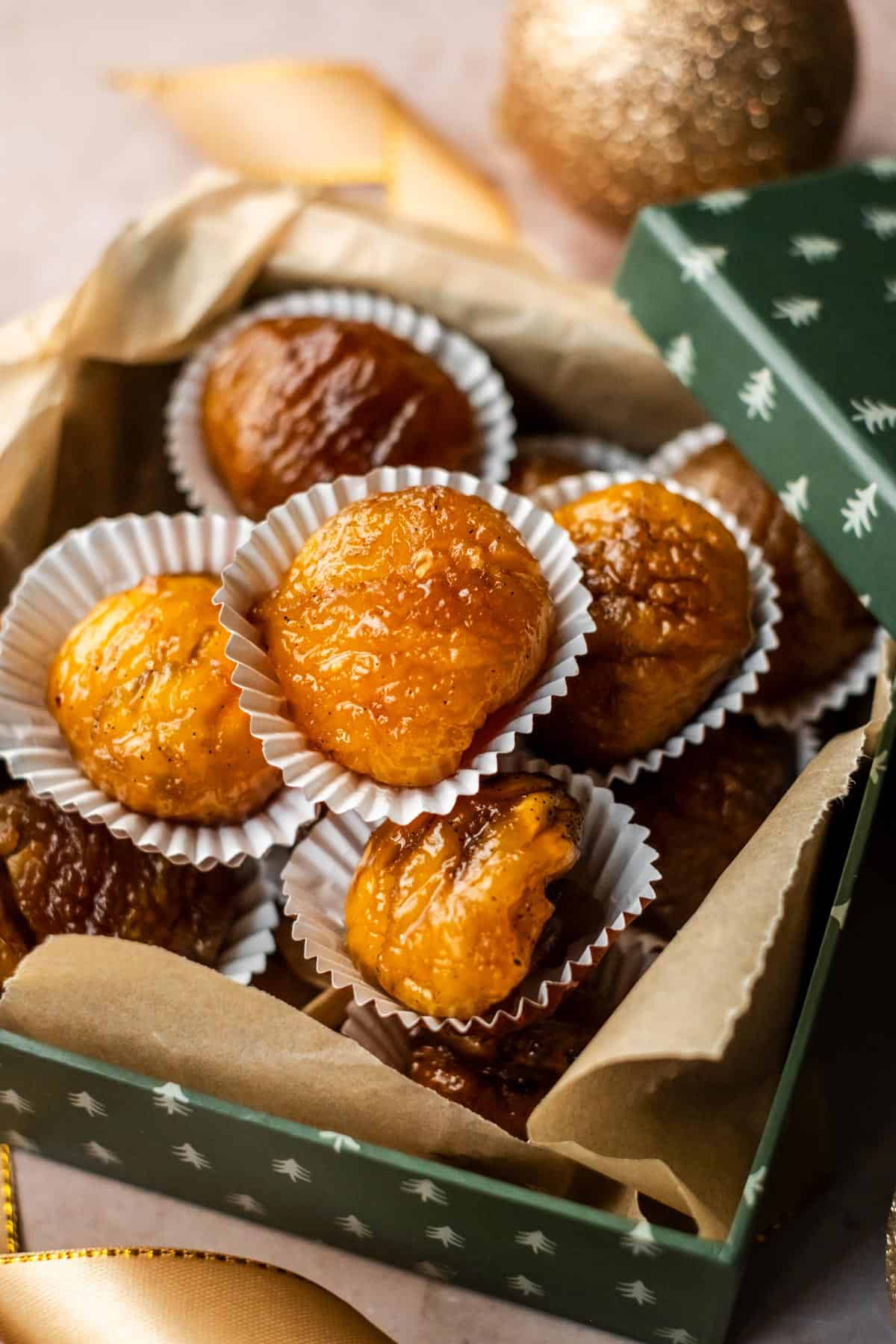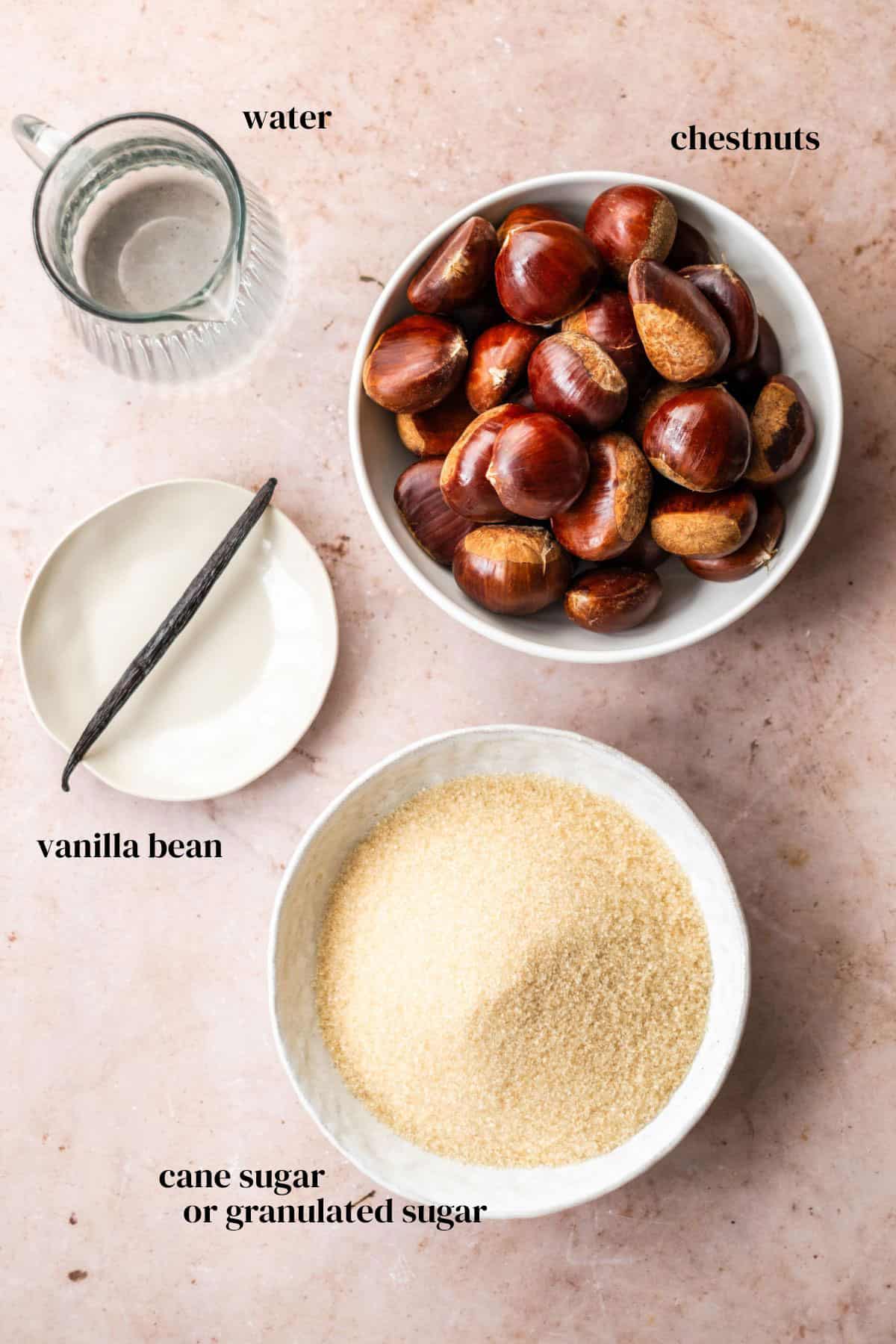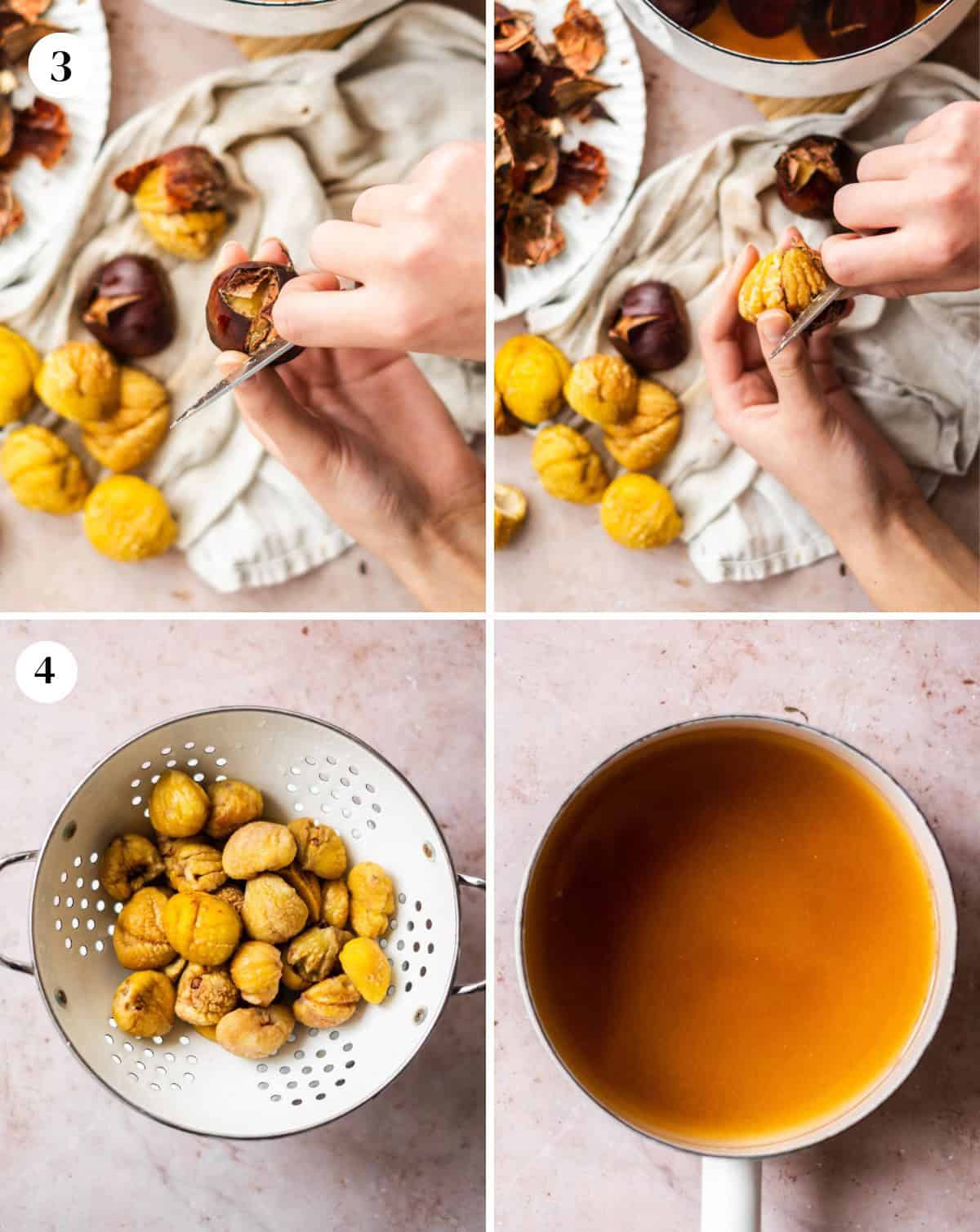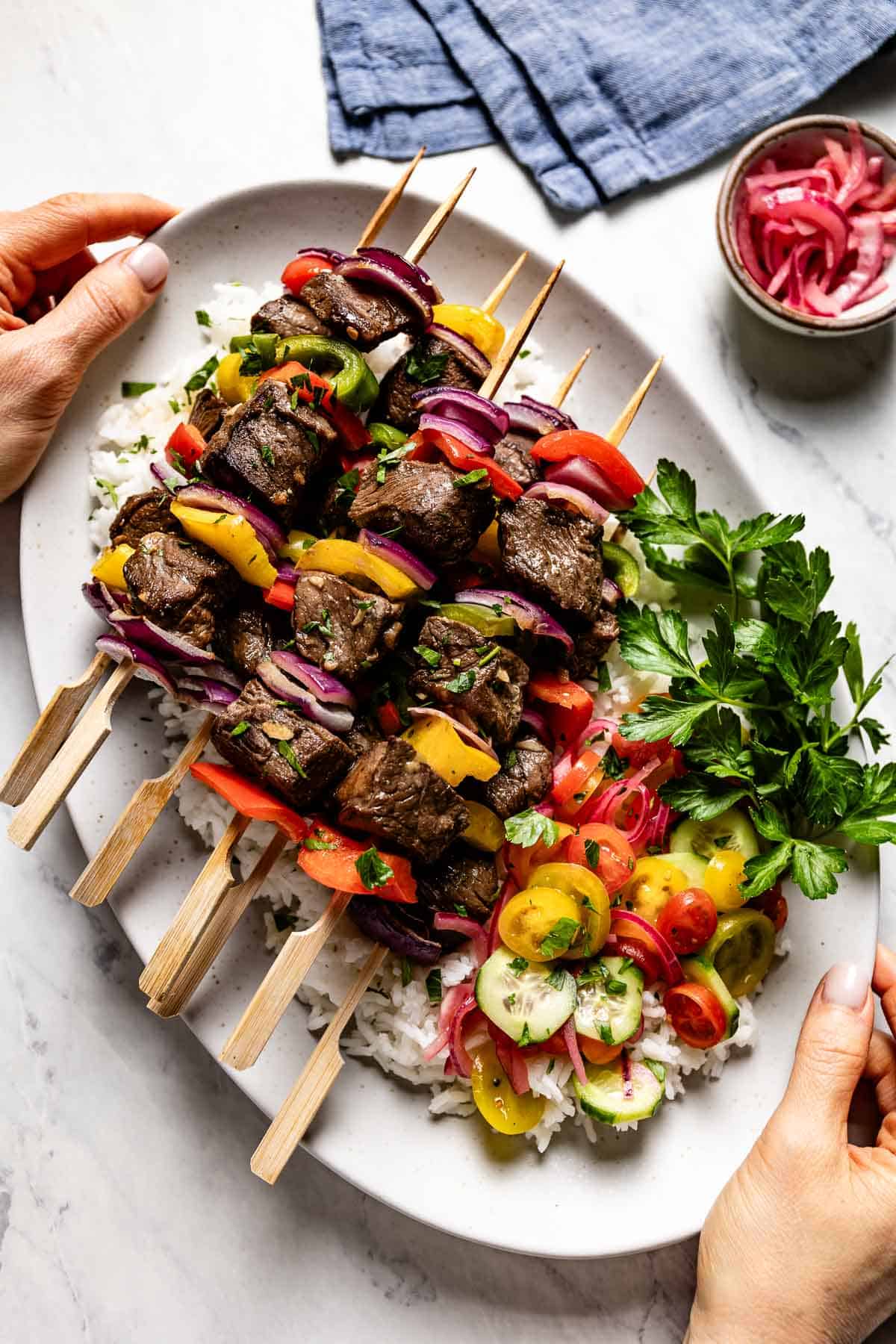Humans have relished in candied chestnuts, or marron glacés, since the 16th century. Marron glacé (sometimes also referred to as Marron Lyonnaise) originated in Northern Italy and France, where chestnuts thrive in the autumn and winter months. While preparing this French chestnut delicacy does take four days, the hands-on time is surprisingly minimal once your chestnuts are peeled.
If you love roasting chestnuts in the oven or over an open fire but are looking to expand your chestnut repertoire, this European classic is a must-try. Yes, the prep time for this marrons glacés recipe may be a bit lengthy, but the process is straightforward and requires no advanced skills. Plus, making these candied chestnuts at home is far more budget-friendly than purchasing them at the store—without compromising that irresistible sweetness!

What is marron glacé made of? The Ingredients List:
Our recipe for candied chestnuts uses just four basic ingredients. However, the success of the end product will significantly depend on the quality of the ingredients you choose.
Below is everything you need to look for when buying them:
Chestnuts:
It is no secret that the chestnuts are the star ingredient in this recipe. When buying chestnuts, there are a few things to pay attention to:
- Get the freshest chestnuts you can find: If possible, we recommend hand-selecting your chestnuts to ensure they are equal in size. Look for those that are plump, smooth, shiny, and without any blemishes or mold. Feel it between your fingers to ensure the skin is not dry. Once you’re back at home, one way to test freshness is to drop your chestnuts in a bowl of water. If any float, discard them, as they’re likely hollow inside the shell.
- Not all chestnuts are created equal: In terms of chestnut variety, the French ‘marrons’ are superior in quality as they tend to be larger in size and more tender in texture. However, it’s hard to find them here in the US. A great alternative is Italian chestnuts, sold at national supermarkets like Whole Foods and Trader Joe’s during the holiday season. For this recipe, we recommend avoiding Chinese chestnuts. While they tend to be cheaper, we find them more challenging to peel.
- Store-bought pre-cooked and peeled chestnuts are a great shortcut: If you’re short on time or don’t have access to fresh chestnuts, you can buy them (affiliate link) from the store. One important thing to remember is you need to ensure that the only ingredient used is chestnuts. Store-bought, already-sweetened chestnuts won’t work in this recipe.

For The Syrup:
- Water: You need a ratio of 1 part water to 1 part sugar to make the sugar syrup the peeled chestnuts soak in.
- Vanilla Bean: Use a whole vanilla pod sliced in half to flavor the sugar syrup. The vanilla beans infuse into the syrup for maximum flavor. We advise you against using vanilla extract if you can avoid it. While it won’t ruin the recipe, we found that much of it evaporates along with the water as the syrup reduces.
- Sugar: Since we do our best to use natural sugars in our recipes, we sweetened the syrup with cane sugar, but granulated white or brown sugar can also be used.
How to Make Marron Glace?
Below are the step-by-step instructions detailing the process of making glazed chestnuts. At first glance, the process might look intimidating, but once you’re done with boiling and peeling the chestnuts, the rest will take no more than 5 minutes a day.
If you’re new to boiling chestnuts, we recommend you first review our guide on How To Boil Chestnuts, as we go into all the nitty gritty details there.
- Score the chestnuts: Use a small, sharp knife (or a paring knife, chestnut knife, or a sharp serrated knife) to score a cross outside the shell, right across the middle or “belly” of the chestnuts. Turn it 90 degrees and cut another one, creating an X. Don’t go too deep with your cuts—you want to pierce through the outer shell and the inner fuzzy skin, but do your best not to cut through the flesh too much.
- Boil the chestnuts in water: Place two cups of cold water into a medium-sized saucepan and boil over medium heat. Carefully drop the chestnuts into the boiling water and cook for 15-20 minutes. Towards the end, you’ll see the cut part start opening up as they cook, revealing the fuzzy skin on the inside. To check for doneness, carefully remove one chestnut and peel to check if the yellow flesh is fully cooked. If the pulp is soft and creamy, it is cooked. Remove the pan from the heat once they are all (mostly) open.

- Peel your chestnuts while they are still warm: Carefully remove chestnuts one at a time from the hot water and hold them using a clean dish towel if they’re too hot. Using a sharp knife, peel off the shell and fuzzy skin underneath. If you’re having difficulty removing it, place it back in hot water for a few more minutes.
- Make the sugar syrup: Place the chestnuts in a colander and rinse them under cool water. Add the sugar and water to a saucepan and bring to a simmer. Stir continuously until the sugar is fully dissolved. Continue simmering for another five minutes until the sugar syrup turns golden brown. If you are using granulated sugar, the syrup should remain clear.

- Cook the chestnuts in the sugar syrup: Add the chestnuts and halved vanilla bean into the syrup. Simmer your marrons in syrup for 10 minutes while stirring gently, being careful not to break up the chestnuts.
- Set aside for 24 hours: After 10 minutes, take the saucepan off the heat, put the lid on, and let it sit on the counter for 24 hours. The chestnuts will cool down in the syrup and soak up some of the liquid as they rest.
- Cook the chestnuts in syrup a second time: The next day, place the saucepan back on the stovetop and gently heat the syrup until it is simmering. Continue to simmer for another 3 minutes. Remove from the heat, place the lid back on, and set aside to cool.

- Cook the chestnuts in syrup two more times: Repeat the process of cooking the chestnuts in syrup two more times, waiting 24 hours between each time.
- Place chestnuts on a wire rack: After the 4th and final round of simmering in syrup, using a slotted spoon, remove the chestnuts one at a time, draining off excess liquid. Place them onto a baking tray fitted with a wire rack. Continue with the rest of the chestnuts one by one and spread them evenly on the wire rack. Make sure you lift out any little bits that may have broken off.
- Dry out the chestnuts in the oven: Preheat the oven to 120F (or as low as it will go) and place the chestnut tray in it. Cook the chestnuts for an hour. Remove the tray from the oven if the nuts have dried and hardened. If they’re still a bit sticky, prop the oven door open and leave the tray inside until thoroughly dried out.
- Serve your marrons glaces: This French confection took effort to make and thus deserves a presentation worthy of your efforts! The best way to serve them is to individually wrap the chestnuts in parchment paper, paper cases, or place them in mini cupcake liners (affiliate link).
How To Store and Freeze Candied Chestnuts?
- To store: Wrap each candied chestnut individually in parchment paper. Place in a sealed container and refrigerate for up to a week.
- To freeze: Store the individually wrapped chestnuts in an airtight container and freeze for up to 1 month. Defrost at room temperature.
Ways To Use Marron Glaces
This candied chestnut recipe is incredibly versatile. Once you’ve made your marrons glacés, there are many ways to enjoy these delicacies:
- Dessert: Make a Coupe Marron. This is a French classic that, I think, is worthy of your caramelized chestnuts. Add a scoop of vanilla ice cream to a tall glass, add your candied chestnuts, and then top it with a spoonful of whipped cream. It’s a simple yet decadent dessert, perfect for holiday entertaining.
- Breakfast: Crumble marrons glacés over your favorite oatmeal, porridge, granola, or stack of pancakes.
- Meat and Cheese Board: Adding a sweet element to a cheese and charcuterie board is perfect alongside savory bites. The nutty, sweet earthiness from these chestnuts makes a beautiful, elevated addition to your serving platter.
Expert Tips
While making this glazed chestnuts recipe is fairly simple, there are a few important details to remember. Here are some helpful tips we’ve learned along the way to ensure your first attempt is a success:
- Patience is key when scoring and peeling chestnuts: Take your time to carefully score the outer shell and fuzzy skin, aiming to pierce the skin without cutting too deeply into the flesh. Once cooked, peel the chestnuts while they’re still hot, as the skin becomes much harder to remove once they cool. Keep a paring knife nearby to help with any stubborn bits of skin that get stuck in the folds of the chestnut.
- Save the broken pieces: Store them in a jar; they will taste just as good. Use them as a topping for ice cream or oatmeal.
- Heat the syrup gently: Keep the sugar syrup at a gentle simmer rather than letting it boil. Also, it is best to stir regularly to prevent the chestnuts from sticking to the bottom of the pan and ensure they’re evenly coated throughout the whole process.
- Watch the sugar syrup level: Towards the end, if your syrup reduces too much, the chestnuts will start sticking to the bottom of the saucepan. If that happens, feel free to add a small amount of water (¼ cup or less) to thin it out and maintain consistency.
- Keep the sugar syrup: Don’t discard the syrup after removing the chestnuts. Pass it through a sieve and store it in an airtight container in the fridge. It’s a great alternative to maple syrup. I love it when poured into cocktails and drizzled over oatmeal and ice cream.

FAQs
In English, marron glacé translates to candied chestnuts. It is a French candy made by simmering chestnuts in a sugar syrup until they become tender and coated with a glossy, sugary glaze.
Marrons glacés are sweet through the center with a hard, sugared exterior and tender, nutty, sweet-tasting flesh.
Marron glacé is expensive because making them is labor-intensive and time-consuming. Each chestnut must be carefully scored, peeled, and cooked in sugar syrup over several days, requiring precision and attention to detail. Additionally, high-quality chestnuts add to the cost, making it a luxury treat.
Other Chestnut Recipes
If you make this recipe, I would greatly appreciate it if you could take a minute to rate it and leave a comment below. It is a great way to support this website and help those planning to make it. Also, if you took pictures, I’d love to see them. Share your creations on Instagram using #foolproofeats so I can share them with the Foolproof Living community.

Marron Glace Recipe (Candied Chestnuts)
Equipment
Ingredients
- 1 ½ lbs fresh chestnuts, should give you 1.25lb/570g when peeled
- 2 cups water, more to boil chestnuts
- 2 cups cane sugar, or granulated sugar
- 1 vanilla bean, cut in half lengthwise
Instructions
- Place the chestnut on a cutting board flat side down. Hold it firmly between your index finger and thumb and make a horizontal slit and then turn the chestnut 90 degrees and make a second cut forming an “X.” Make sure to score through the hard outer shell and the fuzzy skin underneath. Do your best not to cut any deeper into the chestnut flesh. Repeat the same process for all of the chestnuts.
- Fill a saucepan with cold water and bring it to a boil. Carefully place the chestnuts into the boiling water and cook for 15-20 minutes. The cut part will start opening up as they cook, revealing the fuzzy skin on the inside. To check for doneness, carefully remove one chestnut and peel to check if the yellow flesh is fully cooked. If the pulp is soft and creamy, it is cooked. Remove the pan from the heat once they are all (mostly) open.
- Using a slotted spoon, remove one to two chestnuts at a time, as they will be hot. If needed, use a kitchen towel to protect your hands. Carefully peel away the hard outer shell and the fuzzy inner skin, taking care not to break the chestnut. If the fuzzy skin is stuck in the folds of the chestnut, use the tip of a knife or a toothpick to remove it. If the skin is stubborn, return the chestnuts to the hot water for a minute to loosen it, then try peeling again. Once done, you can discard the shells, skins, and cooking water.
- Place the now-boiled chestnuts into a colander and give them a quick rinse. Set aside.
- To make the sugar syrup, add 2 cups of water and sugar to a medium-sized saucepan and bring it to a simmer over medium heat. Stir it continuously until the sugar dissolves. This should take no more than 7-9 minutes.
- Carefully add the vanilla bean and chestnuts to the sugar syrup. Let them simmer for 10 minutes, stirring once every 2-3 minutes.
- Turn the heat off. Carefully remove the vanilla bean and discard it. Put the lid on and let it sit at temperature for 24 hours.
- After 24 hours, return the pan to the stove and bring the sugar syrup to a simmer, cooking the chestnuts for 3 minutes. Stir the syrup and chestnuts every few seconds to keep them from sticking to the pan. Once again, remove the pan from the heat, cover with a lid, and set aside at room temperature for 24 hours.
- Repeat this process twice, heating and cooling every 24 hours (it should be 4 times in total).
- Line a baking sheet with parchment paper and place a wire rack over it. Preheat the oven to 120F (or as low as your oven can go.)
- After the final time, carefully remove them one at a time with a slotted spoon. Let the syrup drip off as much as possible. Spread the chestnuts on the wire rack.
- Transfer the baking sheet to the preheated oven. Bake low and slow for 1 hour*. The chestnuts should be dry and hardened on the outside. If they’re still sticky, turn the oven off, open the door, and leave the chestnuts to continue drying inside.
- To serve, individually wrap the chestnuts in parchment paper or cellophane or place them in mini cupcake liners. Gift and/or enjoy.
Notes
- Yields: This recipe makes about 18-20 candied chestnuts, depending on the size of your chestnuts. I listed the serving as 10 (2 per person) and the nutritional values below are per serving.
- Short on time? If you are planning to gift these candied chestnuts and make a bigger batch, you can save time by buying already cooked and peeled chestnuts. Just make sure that the only ingredient listed on the packaging is chestnuts.
- Heat the syrup gently: As you warm up the sugar syrup, keep the sugar syrup at a gentle simmer rather than letting it boil. Also, it is best to stir regularly to prevent the chestnuts from sticking to the bottom of the pan and ensure they’re evenly coated throughout the whole process.
- To store: Wrap each candied chestnut individually in parchment paper or mini cupcake liners. Place in a sealed container and refrigerate for up to a week.
Nutrition
Nutrition information is automatically calculated, so should only be used as an approximation.


















I love this recipe. Thank you for sharing it. I love candied chestnut. I’ll try it ASAP.
I am thrilled to hear that you liked them Huri. Thanks for coming by and taking the time to say hello.